Testimonies
Here is a selection of testimonies submitted to us via e-mail or Facebook, and originally published on our Hungarian-language website. These testimonies were selected and, unless stated otherwise, translated into English by Gwen Jones. To submit a story, please write to bertalan@ceu.edu.
2014. May 08., Thursday
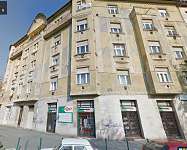
My grandmother and her family lived a few houses down from us, and we were very lucky because their house was designated a yellow-star house in the summer of 1944. Whoever was not Jewish was told they could move anywhere, in fact they received assistance too, and could go to live in an apartment that Jews had been forced to leave. But interestingly, in that house, many non-Jews stayed on. My mother and I moved into one of the rooms, and anyone left form our family came and moved in with us, so they didn’t have to live with strangers. And so in that apartment lived my grandmother, her three daughters (whose husbands were on forced labor service), and all their children, plus my uncle Aladár, his mother-in-law, wife, and their small child, whose biological father they never saw because when the child was born, he’d already been on forced labor service for a long while. I was there together with my mother. There were 12 of us in a three-room apartment, plus one woman we did not know.
My mother and her younger sister Piroska survived, although in 1944, in the yellow-star house, they received a summons to the Óbuda brick factory, and off they went. They took their coats, walking boots, and something to eat. My mother was not a practical person. She was terrified of every action, but her sister was a very resourceful type. Later they said that there was such chaos in the brick factory, such a senseless amount of women and old people, that they couldn’t fit them all on the wagons, it was mayhem. My aunt said to my mother, “Hey, let’s get out of here.” My mother didn’t dare, but my aunt insisted, and so they escaped and came home to the yellow-star house. After that we were terribly afraid that one of the neighbors would denounce them. But nobody did. And that’s how they missed the wagons destined for Auschwitz. So only my mother’s family survived. Where we lived in the yellow-star house, there was a very kind Christian lady whose 15-year-old son who, how should I put it, expressed great attraction towards me. And for days this guy would go to our old abandoned apartment and put as much as he could of my grandmother’s stored food from the larder into a backpack and bring it to us for as long as entry into the ghetto was still possible. He brought us lentils, split yellow peas, onions, potatoes, everything we had stored under my grandmother’s supervision in the summer of 1944, because meals had to be so carefully planned. This was a huge help, since in practice it meant that although we were terribly hungry, we didn’t starve, unlike many older people who did die of starvation there. We couldn’t stay in that apartment for very long, because when the siege and bombing of Budapest began, one of the bombs hit the house next to us on Kisdiófa Street 5. As a result, the stairwell of Kisdiófa Street 3 came away from the wall. Everyone was terrified and the entire house moved downstairs into the basement. In fact the entire ghetto lived in basements. There was no other way. We took what we could with us down into the basement, and although the other staircase remained in tact, nobody dared to go upstairs because of the constant bombing, cannon fire and shooting.
From the Centropa archive.
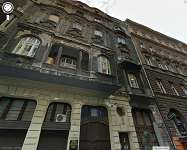
Since my dad was working in the match factory, which was a Swedish-owned company, my mother received a Swedish protection letter. First they were in the yellow-star house at Csáky Street 3, which was a place of worship. Later, when the protection letters were in circulation, Aunt Jolánka and my mother went to the Swedish protected house on Hollán Street. But one day the Arrow Cross came at the beginning of November, and cleared the house out. They took everyone to the brick factory and from there to Bergen-Belsen. My mother also ended up in Bergen-Belsen, as did her parents.
From the Centropa archive.

One of my father’s good friends had a basement facing the street at Hollán Street 3, which is where we were later in the yellow-star house. They lived on the fifth floor and he was also a chemist who specialized in cyanide. At that time, Budapest apartments were full of bedbugs, and it was simply impossible to get rid of them. People got cyanide pest control in every year, but there were still bedbugs everywhere. You had to leave the apartment, which was hermetically sealed, they pumped in the cyanide and 22-24 hours later, they aired the place, and then you could go back in and clean up. On top of this, every week my mother took all the beds apart with the maid, since those old-type beds could be disassembled. She sprayed them with petrol and cleaned out all the holes and cracks with pieces of wire, took the pictures down from the wall, so it was awful work, and still there were bedbugs. It was impossible to get rid of them right up until the end of the war. My father’s friend’s workshop and storage space were in the basement of Hollán Street 3, and during air raids I had to walk over there from school. It wasn’t very far, but I can’t say how frightened I was on the way!
I told my father that the Germans had arrived. He called one of his friends on the telephone who confirmed to him that yes, they really had arrived. We were really nervous until that evening, when my mother’s family turned up. And then everything moved like lightning: they disconnected the telephones in Jewish apartments, you had to return your radio set, and very soon, move into a yellow-star house. Paulay Street 12 did not become a yellow-star house, and so we had to leave. In school they quickly issued certificates from the second class, because this was a shortened academic year and after that there was no more teaching. I remember things started to go very bad when my father packed up his pistol—it turned out he had one—and some Communist literature, tied them up in a parcel and we went to the Chain Bridge to throw it into the Danube. We lived with my father’s friends on the fifth floor in the yellow-star house at Hollán Street 3. There was also a couple living in the bedroom who’d also been forcibly moved, like us. In the yellow-star house, apart from having to wear the yellow star, there were also regulations about when we could go out into the street. We couldn’t work, and everyone lived from their savings. We children played with the other children in the house. Since we couldn’t go outside onto the street, we always played in the stairwell. And then one day they came to take my parents away. The Gestapo took them some time in August. I went upstairs and two guys—just like in the films, wearing caps and mackintoshes—were leading my parents away. I tried to obstruct them, these two people hadn’t done anything wrong, and they just swept me aside. And then, just like in the films, a little car took my parents away to the Majestic hotel.
From the Centropa archive.
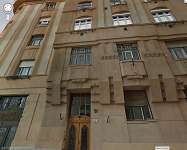
First we lived in a Jewish [yellow-star] house, and brought our relatives over to live with us, one of my aunts, Jolán Schlesinger, who later became Mrs. Richárd Schwarz. Once we had a two-room apartment with a bathroom, we brought another family over. This was at István Road 40. The other family had four members, and the families had one narrow room each. Then Jolán Schlesinger and family moved out, but I don’t know where. They survived the war. Later, with my older sister’s help, under Swiss protection, we moved into Katona József Street 41, where other families were already living together in one room. That was already too much, and from there we could see the atrocities at the Danube, where my uncle and cousin, among others, were killed: they shot József and Gyuri Natonek into the Danube. My older sister saved my parents by going up to one of the Arrow Cross man who, it appears, understood why she was sad. My parents were called up from the basement, and went back to the protected house, where we met again, I returned there myself a bit later.
From the Centropa archive.
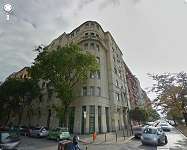
In the ghetto, I learned that my Aunt Etel and her daughter-in-law Manci, together with her ten-year-old grandson Bandi, were staying in a basement at Wesselényi Street 4. Uncle Ignác, Etel’s husband, had been snatched away; we don’t know which death camp he was killed in. Aunt Etel and remaining family were forced to move into the yellow-star house at Sziget Street 40. They were sent to the Óbuda brick factory too, but the old people and parents were allowed to go back home. They could have returned to their apartment, but had moved into the ghetto two months earlier, and their apartment was there on the fourth floor, where the daughter-in-law sometimes went to cook, until she noticed that the roof of the house opposite was higher than usual, and was crumbling to pieces.
A Russian bomb had fallen on it. The Germans had installed automatic guns on countless rooftops at the junction between Wesselényi Street and the ghetto, which they used to try to dispel the Russian military airplanes which appeared regularly every day. They dropped small-sized bombs which regularly caused varying damage not to the air-defense guns, but to the neighboring houses. In fact Jews didn’t have to move out from Sziget Street 4-6, three or four Jewish families stayed behind. One of whom, the wife of a cobbler, seeing my distress, offered me schnitzel made with powdered egg. The house wasn’t designated as a yellow-star house. This was thanks to the vice-concierge’s son, who was an Arrow Cross party activist. They didn’t take over the apartment vacated by my father, we didn’t suffer Arrow Cross raids, and when we had to move, the residents said goodbye. This was exceptional, a unique case in the history of the Arrow Cross rule in Budapest. Our preparations were very chaotic. First we used up Aunt Etel’s limited food reserves. Her last “hobo” apartment before they had to move into the ghetto was in the Palatinus house at the end of Sziget Street. She asked us to bring her the things she’d left behind in a car. I filched a piece of elbow piping so there was no more impediment to laying a fire in the oven in the maid’s room. We dug out the stamp collection which had been hidden underneath a pile of coal in the coal cellar, and one part of my deceased mother’s jewelry. The other half was hidden by a dear friend, Mrs. Pilát, who gave it back in one piece.
From the Centropa archive.
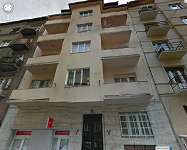
I never experienced any antisemitic incidents before 1944, when someone punched me on the street. We were very afraid in 1944 after the Arrow Cross took over, and took the Jews to the Tattersaal racing track. When the Arrow Cross went from house to house, I remember being very frightened.
And then we escaped this in the house, because my grandfather had a false paper that said he had been condemned to death during Béla Kun’s rule. He showed this to the Arrow Cross and they decided that we could stay at home. The others from the house returned two days later. They didn’t take us away from the house, and again this was due to my grandfather’s genius, because he acquired a fake Swiss protection passport, of course it was perfectly clear that the stamp on the passport was fake. So he made a photocopy of it, and I remember that the whole family’s name was written on it: him, my grandmother, my mother and me, and we went to the corner of Rákóczi Road and the Boulevard where there was a public notary. And he had the photocopy certified, and from that point on we presented our certified copy of a fake document. My grandfather was a very, very refined person. The house on Szövetség Street was declared a Jewish house. I think the majority in the house was Jewish anyway. Although the area around it was not a Jewish area, the house was designated a Jewish house. That’s where we were during the war. And I also remember that on the ground floor there lived someone called Keresényi or something like that, who bought me ice cream from the cake shop opposite, because Jews couldn’t go into cake shops. After the Arrow Cross took over, we had to leave the house: there was some office on Pozsonyi Road and that’s where they designated a protected house for us at Tátra Street 29/b. The apartment wasn’t that crammed full. I don’t remember who we lived with. We’d go down into the basement where there might have been a carpenters’ shop and that’s where we were during the bombings. We cooked there together. I remember eating a bean stew where, instead of using bicarbonate of soda to soften the beans, someone had added anti-moth powder by accident. But we ate it anyway. And that’s where we were liberated, but the Arrow Cross were already going from house to house and taking the Jews to the Danube banks. If the Russians hadn’t arrived two days later, we would have died there too. Countless people died in the Holocaust. Forty from my family. In the family tree I made, there are over 200 hundred names, and I made the tree so my children would know where they come from. I worked on it for years, and when I was in Israel I tried to supplement the information. It’s now finished.
After the war, we went back to Szövetség Street. Some things remained in our apartment, some things had gone. Most of the furniture survived. But my Märklin railway had disappeared. I remember that we didn’t have anything to eat in 1945, and there was a family in the house called Wintermantel, who were jewelers and Christians. They had two children, and I made a deal with them: I’d give them my Märklin railway in exchange for food. But when I went to look for it, I saw it had been taken, it was gone. So the deal was off.
From the Centropa archive.
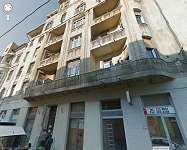
In June 1944, we moved from Munkás Street to the yellow-star house. We had to leave our apartment by 10 pm. Whoever couldn’t find a place to live, the congregation tried to find them a place in one of the yellow-star houses, in other words an apartment. We got up at dawn, got dressed, and then a car came for us, and then we came here, to the yellow-star house at István Road 20, on the fourth floor, no. 50-51. I should also mention our concierge, a lady around 57 years of age, she was a fragile woman who took on a 5-story house with 60 apartments during the war years, and so she had lots to do as concierge. It is thanks to her, Auntie Margit Keszte, that the affairs of the entire house were sorted out, and so we never had any problems, and there were so many of us living there. Lots of families lived in those 60 apartments, at least 300 of us. There were many old people and families too.
I am amazed that this fragile little woman managed to do so much, and led the house in such a smart way, at the price of numerous battles. It wasn’t enough for Auntie Margit to look after us, she also had to conceal one of the residents, who was an actual baron, and who produced protection letters on the quiet. They lived on the third floor. He produced them there, there were people hanging off the door-handle, you couldn’t even close the door before the next person arrived. He produced these protection passports and letters not only for the residents, but for others outside the house too. The blinds were pulled down, and all the decent left-wing people met there, that’s where they held meetings. The baron belonged to Wallenberg’s group, and after the war, he had to leave Hungary immediately, without his family, otherwise they would have taken him away. So a few months after we came home in 1945, he left without his family. Auntie Margit’s son Lajos, who was a cabinet-maker, made a large three-door wardrobe. You could go through a wallpapered attic door into the fifth-floor apartment. And that’s where they placed the large, heavy, three-door wardrobe. They stuffed heavy rags underneath it, and Lajos fixed it so the back panel could be opened. So you could go through the wardrobe. He opened the wardrobe, at the back they removed the panel, so food could be handed over. That’s where we hid when the Arrow Cross came. The children in the house really loved Auntie Margit, and we always hung around her apartment. We had to accompany residents up the stairs so that the elevator wouldn’t break down. We were all given tasks. In 1944, I already had an elevator operator’s certificate, because Auntie Margit taught us how to work the elevator so that we wouldn’t have to call the mechanic out so often. We accompanied everyone upstairs and then called the elevator down. But Auntie Margit herself was given orders when the Arrow Cross came, when she looked around and said, children, into the elevator. Underneath the elevator was a 1.5 meter high box which went down into the elevator shaft. The back of the box had been taken out so we children could be sat in there. They said: this elevator is moving slow. We were suffocating but shut our mouths so that nobody noticed anything. I have to say, you didn’t have to think, for the whole time there you just acted on instinct. There was always a young Wehrmacht soldier standing at the front gate, whom we called Matyi. He just stood there, not admitting any strangers, I don’t know what his orders were. When we came back, we looked for him and were told that soon after we were taken away, he had to leave too, and he fell in the siege of Budapest. I was really sorry for him, because he was only 21. And he was such a nice boy. Diligently, he came to work every day and stood there from morning until night, and no Arrow Cross people could enter.
From the Centropa archive.

For eleven months we went from one house to the next, with ever diminishing luggage. We lived on Alpár Street, then on Nefelejcs Street, on Pozsonyi Road in a protected house, and from there they took us to an Arrow Cross house on Teleki Square, and then back to Pozsonyi Road. We were often hungry and thirsty. We were terribly thin. Weeks passed when we didn’t even have drinking water, and not even the toilet worked, and there were 40 people in one apartment: this was on Pozsonyi Road. They brought wounded people in too, one had been shot through the kidneys and bled to death there. We stepped over the congealed blood in the middle of the room. Jews were not allowed to go outside, there was a curfew in force. The houses were closed up and guarded by armed men, both yellow-star and protected houses, this was in December 1944.
From the Centropa archive.
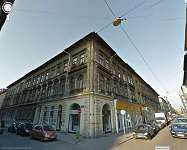
My name is Judith Borstein and I reside in Los Angeles, California currently with my family. I was a forced resident of Bajnok Street 21, VI. district, Budapest with my mother Vera Grunfeld along with my Aunt Magda Wachsmann and her daughter Lilla Wachsmann (later Verhovay) and several other friends from June 1944.
My Mother was forced out from her apartment from Kőbanya and herded into this “Yellow-Star House” after which she shortly went into labor with me on June 26th and gave birth to me at Weiss Aliz Hospital in Budapest. Afterwards, she was forced to return to Bajnok Street 21 and we all resided there until the Arrow Cross Hungarian SS guards liquidated the “Yellow-Star House” and force-marched all the residents in lines 10 deep to be shot into the Danube. My Mother, cousin Lilla and I escaped from this death march, miraculously, a guard actually agreed to turn around and allowed us to escape out of this line.
I very much want to register for this event and have our story and survival registered as part of this important commemoration to be preserved for posterity.
Concurrently, at this same time at the end of June 1944, my maternal grandparents, Dezső and Gizella Winternitz, who were herded into a ghetto near Budafok where they originally resided, were deported to Auschwitz on the cattle-cars, where they were murdered in the “mass gas showers” by the Nazis. Incidentally I have copies of three handwritten notes they threw out of the cattle-cars while in transit to their annihilation.
On my father’s (Jenő Grunfeld) side, half our family were murdered and those that survived were emotionally scarred and damaged for the rest of their lives. My father survived the Holocaust by performing slave labor at different camps from Hungary, Austria and Siberia where he actually walked home from after the liberation in 1945. He contracted typhoid in Russia and was an invalid and bed-ridden for a year after he returned to Budapest.
He was a broken man for the rest of his life and could not recover from the accumulated trauma he endured from 1938-1945.
Our miraculous escape was due to a good-hearted young uniformed boy (“levente”), who happened to know my aunt Vera by name. He gave her a kerchief to cover her head, and we just walked out of the forced march, and no-one noticed. Then we went to my uncle's fellow-soldier's wife, who lived in a Roma/Gypsy community called “Tomori telep,” at that time in Budapest’s 4th district. She gave us shelter (unfortunately, I don’t know her name) and we were hiding there until about April, 1945. My mother was sent to Germany – Ravensbruck and Leipzig, my father, as a forced laborer, to Bor. That’s why I [Lilla] remained with my Aunt. My parents both returned, but my paternal grandmother died in the Budapest Ghetto, his sister and her husband both were lost somewhere during the war. This is our complete “story.”
While the Hungarian Government finally publicly acknowledged its own eager and guilty role of complicity with the Hitler Regime and formally apologized for the extermination of over 500,000 Jews, it is pertinent that its CURRENT POPULATION be made aware of all details of the inhuman horrors that it inflicted on its Jewish population.
It is all the more crucial to have this Public Commemoration now of the “Yellow-Star Houses” since there are some parties and individuals who are trying to re-write and falsify Hungary’s true historical role in the second World War from 1938-1945 including re-writing textbooks that will teach its current and future generations falsified information and not the actual cold brutal historical facts that actually happened and were recorded by bona fide historians as well as the survivors during this period.
It is also important to note that THE MANDATE to force all Hungarian Jews into the HOUSES WITH THE YELLOW STARS was issued during the Horthy Regime, the leader that many Hungarians are trying to glorify currently (with some governmental support) and there have been numerous new statutes erected in his honor in public places, even in Budapest.
Incidentally, my father’s original surname was Jenő Grunfeld, which was changed officially to Gábor (and Lilla’s to Verhovay) after the war as many Hungarian Jewish survivors did in order to be able to obtain employment in order to be able to support their families. Yes, the ugly head of antisemitism rose during the Communist era as well although it was more covert.
Unfortunately antisemitism was always prevalent throughout most of Hungary’s history.
When we emigrated to the USA (my father, mother, Vera Gabor (Winternitz) and younger brother, Peter Gabor) during the 1956 uprising, my father’s name legally became Eugene Gabor. After my marriage to my husband, Dr. Irving Borstein in 1964 my legal and current name is Judith Borstein.
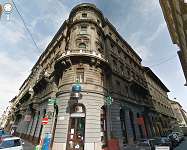
The house on Teréz Boulevard was not a yellow-star house, which is why we had to leave our apartment. The house we moved to on Jókai Street belonged to the Foncière insurers, whose office was on the second floor, even when it became in a yellow-star house from June 1944. From the end of October 1944 [after the Arrow Cross took power], it was a refuge for Swedish diplomatic employees, and under diplomatic protection, run by Raoul Wallenberg. The apartment on Jókai Street was a smaller, three-room apartment. This was a forced exchange.
My mother, father, brother, aunt and uncle Károly also lived there. When Wallenberg was working, there were already too many of us, with at least 20-25 people in the apartment. We were squeezed into one room. Some Christian residents who hadn’t left were still living in the house, including the concierge. At the break of day on January 8, 1945, and on the basis of the concierge’s “charitable deed,” an armed Arrow Cross company appeared. He might had told them that there were Jews here, unlawfully, in case there was anything left they could steal. I don’t know. What’s important is that a couple of Arrow Cross men appeared that night. I was 11 years old at the time. The whole company—whoever could still move, because whoever could not was shot in the head, this is how it was—was taken to the Arrow Cross house at Városház Street 14. This also came to the attention of Wallenberg, who appeared in the Arrow Cross house, and so the next day we were taken to the Pest ghetto, to the house at Akácfa Street 54. Over the next few days, my father and uncle were taken to the banks of the Danube, where they were shot into the river. Naturally, their corpses were never recovered. Liberation took place on January 18, 1945.
From the Centropa archive.